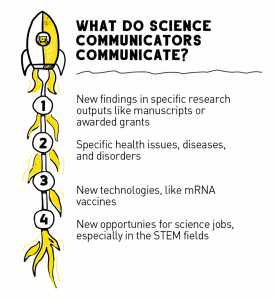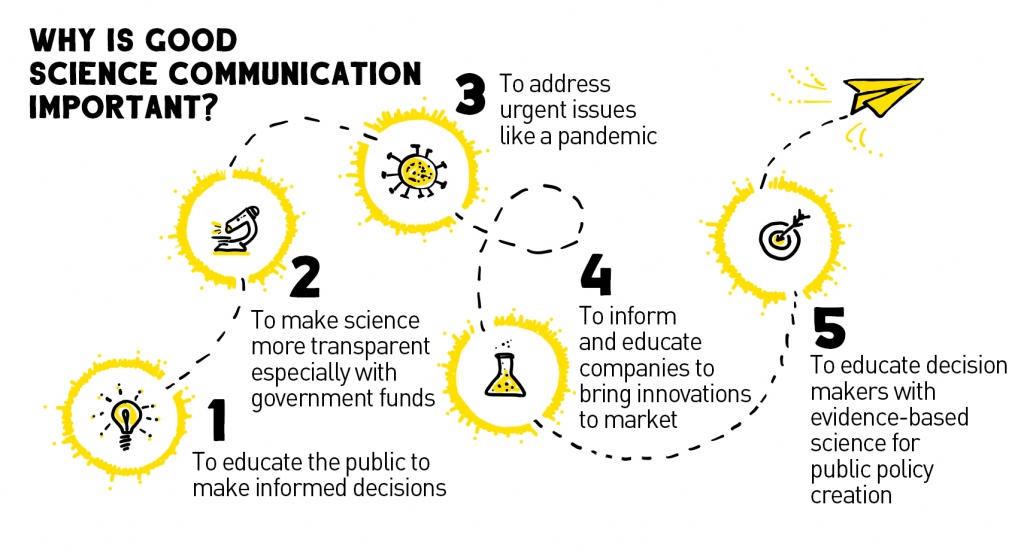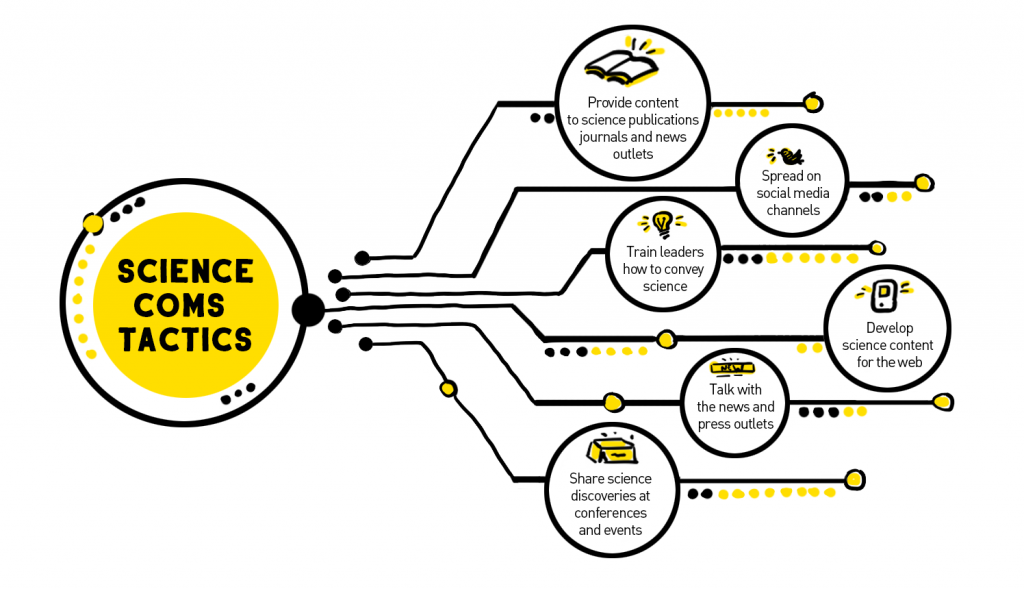An Everyday DNA blog article
Written by: Sarah Sharman, PhD, Science writer
Illustrated by: Cathleen Shaw
The ability to sequence and analyze an organism’s DNA revolutionized the field of biology, allowing researchers to understand how the genome functions and how changes in the genome affect all life on earth. Careers in the fields of genetics and genomics are booming. In this Everyday DNA blog series, Careers in Genomics, we will learn about different career paths in genetics and genomics.
Let’s face it, scientific discovery has a pretty major impact on our lives. It is incredibly important for helping us understand the world around us and make informed decisions. It has led to major advancements in medicine, technology, and agriculture, improving our quality of life and longevity. Scientific research also informs public policy and helps address global challenges such as climate change and pandemics.
Bringing information about scientific breakthroughs from the lab to the general public is extremely important for enabling everyone to benefit from those discoveries. We saw this first-hand during the Covid-19 pandemic. Science communication played a critical role in the global response to the pandemic. With so much uncertainty and rapidly-evolving information, it was essential to have reliable and trustworthy sources to guide public health decisions and policy.
Effective science communication helped disseminate accurate information about the virus, its transmission, and prevention measures to a broad audience and was essential in debunking myths and misinformation. Scientists, public health officials, and journalists worked tirelessly to communicate complex concepts in an accessible and understandable way, helping people to make informed decisions about their health and safety. Clear and accurate scientific communication is vital in addressing public health challenges. Let’s learn more about the world of science communications and the types of careers available to pursue.
What is science communication?
 Science communicators have the exciting and essential task of bringing the wonders of science to life for everyone. They are the storytellers who translate complex scientific ideas into language that is easy to understand and engage with. The main goal of any form of science communication is to inform and inspire the public about scientific knowledge. It involves conveying complex scientific concepts and research findings to a broad audience through various media, such as written pieces (including this blog!), videos, podcasts, social media, and public presentations.
Science communicators have the exciting and essential task of bringing the wonders of science to life for everyone. They are the storytellers who translate complex scientific ideas into language that is easy to understand and engage with. The main goal of any form of science communication is to inform and inspire the public about scientific knowledge. It involves conveying complex scientific concepts and research findings to a broad audience through various media, such as written pieces (including this blog!), videos, podcasts, social media, and public presentations.
Science communication promotes scientific literacy and understanding among the general public, while also fostering two-way communication between scientists and their stakeholders. Effective science communication is essential in building trust between scientists and the public and in informing public policy and decision-making related to science and technology.
There are formal careers in science communications, like my job as a science writer. But science communications is also a large part of other jobs in the biotech field and beyond. For example, scientists must wear the hat of science communicators when sharing their findings with public information officers, grant funding agencies, and the general public.
The topics that science communicators cover are endless. On a broad level, some science communicators working for universities, research institutions, or science journals communicate new findings from specific research outputs like research manuscripts and awarded grants. Other science communicators focus their efforts on informing the public about specific diseases, disorders, and health issues. Oftentimes, these individuals work for non-profits or hospitals aiming to raise awareness about diseases for educational or fundraising purposes. Science communicators also aim to educate the public on new technologies. During the Covid-19 pandemic, it was paramount that science communicators help rapidly educate the public about the mRNA vaccines because it was a technology not many people were aware of or understood.
Why is science communication important?
Accurate and engaging science communication is important for various reasons, the most basic being the dissemination of scientific knowledge and its practical applications. By sharing scientific research findings with a broad audience, science communication can help to ensure that the benefits of scientific research are widely understood and can be applied in various contexts, from medicine to engineering.
For this reason, a lot of science communications are simply produced to educate the public. This increases public engagement on the most critical issues facing our planet. People who are accurately informed are more likely to participate in science advocacy and clinical trials and trust novel technologies like new disease treatments. By making scientific concepts and research findings accessible and understandable to a non-scientific audience, individuals can make informed decisions about health, the environment, and other issues that are impacted by scientific research.
Additionally, science communication is important for building trust between scientists and the public. By making scientific research more accessible and understandable, it helps to ensure that scientific findings are perceived as objective, reliable, and valuable. This can help to build trust in the scientific community and promote public support for scientific research. A lot of basic science is funded by the public through government grants. It is important that the public has access to learn about what research is ongoing in our country. A large percentage of academic research is stuck behind academic journal paywalls. Science communicators can help to bring the research out from behind the veil and make it accessible and understandable to the public.
Science communication is also useful for educating decision-makers like government officials. In today’s advancing world, policy decisions are often based on complex scientific research and data. Science communicators play a crucial role in translating this research into language that is accessible and understandable. Effective science communication can help to bridge the gap between the scientific community and policymakers, enabling informed decisions that are based on sound evidence and data. In this way, science communication is essential to promoting evidence-based policymaking and ensuring a brighter future for all.
Finally, science communication can also help to increase public engagement with science and promote interest in science-related careers and education. By making scientific research more accessible and interesting to the public, science communication can inspire individuals to pursue careers in science and technology. It can also help to foster a broader appreciation for the role of science in society.
Who’s who in science communication
The broad field of science communication encompasses technical writing and editing, medical communication, scientific research writing, science journalism, public relations for scientific and health organizations, environmental communication, and marketing. Each uses their communication skills to bring scientific knowledge to the public.
Science communicators work across multiple fields, including government organizations, museums, universities, non-profits/hospitals, science education centers, biotech companies, magazines, news stations, and newspapers. There are an unlimited number of careers under the science communication umbrella, so we will just focus on a few below. 
Science writer
Science writers specialize in communicating scientific information to a broader audience through the written word. They play an essential role in bridging the gap between scientists and the public by translating complex scientific research into accessible language. Their job involves writing articles, news stories, and other content about scientific discoveries and advancements.
To become a science writer, you need a background in science, journalism, or both. Many science writers hold advanced degrees in a scientific field and have experience writing about science-related topics. Others may have a degree in journalism or a related field and gain expertise in science writing through on-the-job experience and training.
Science writers aim to make scientific research and knowledge accessible to the general public. They strive to convey the significance of scientific research and its potential impact on society through engaging and informative articles. Science writers are an essential part of creative teams that encourage scientific literacy and public engagement with science and technology. Through their work, they help promote a greater understanding and appreciation of science.
Graphic designers/medical illustrators
Graphic designers focusing on science communication play a role in visually communicating complex scientific information to a broader audience. Their job involves designing graphics, illustrations, and other visual aids to help clearly explain scientific concepts and research findings in a fun and interactive way. They work closely with scientists and science writers to create visual representations of data, models, and experiments that are both accurate and visually appealing.
To become a graphic designer in this field, one typically needs a combination of artistic and technical skills, as well as knowledge of scientific principles and terminology. Many designers hold degrees in graphic design or a related field, and some also have a background in science.
By creating visually compelling graphics, designers can help people understand complex scientific concepts that may be difficult to grasp through text alone. They also play a critical role in promoting scientific literacy and inspiring interest in science and technology.
Audiovisual communication
Videographers aim to visually convey scientific concepts and discoveries to a broader audience. Their job involves working closely with scientists and science writers to produce videos, animations, and other multimedia content that help explain scientific research. To become a videographer in this field, you typically need good technical skills in video production, animation, and post-production, as well as an understanding of scientific principles and terminology. Many videographers hold degrees in film production or a related field, and some also have a background in science or engineering.
Through their visually stunning videos, science videographers make science accessible and engaging to the general public, breaking down barriers and encouraging everyone to explore the world around them with a scientific lens. By bringing science to life in a way that is both informative and entertaining, they inspire interest in science and promote scientific literacy. Ultimately, their work helps to make science more approachable, relatable, and fascinating to people of all ages and backgrounds.
Science podcasts are gaining popularity, offering a unique way for people to engage with science and learn about the latest research and discoveries from experts in the field. They provide a platform for scientists and science communicators to share their knowledge and passion for science with a wider audience, offering a window into the fascinating world of science. With the convenience of listening anytime and anywhere, science podcasts are becoming an increasingly popular way for people to stay informed about the latest scientific developments and explore new topics that pique their interest. As a result, science podcasts play an essential role in promoting scientific literacy and encouraging more people to explore the wonders of the natural world.
Check out HudsonAlpha’s science podcast, Tiny Expeditions, here.
Overall, science communication plays a crucial role in promoting scientific literacy, building trust, and advancing the use of science and technology to address societal challenges.


